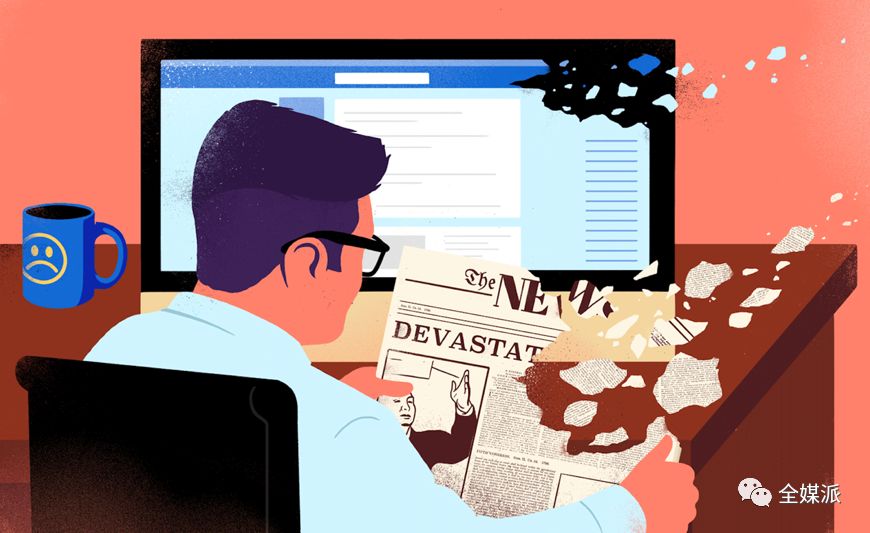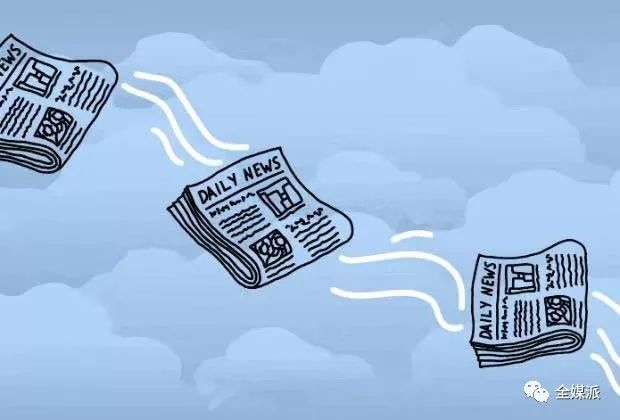Is it a redemption of digital transformation, or is it a trap for self-destruction?
Editor’s note: This article is from WeChat public account “All Media”( ID: quanmeipai), author Tencent Media.
At the end of December 2018, dozens of newspapers, including the Beijing Morning Post and the Heilongjiang Morning News, announced that they would suspend publications and suspend publications. The world is hot and cold, and the days of foreign paper media are not good.
digitization How does the paper media survive in the times?
The answer given by the recent American newspaper industry is to reduce the number of days of issuance and transform the “daily” distribution mechanism into a combination of “digital + paper media.”
Although the transformation movement has spread throughout the major cities of the United States, the industry is still full of doubts about this – what are they facing self-salvation towards digital transformation, or is it a revenue-losing revenue from Waterloo?
This issue of the full media (ID:quanmeipai) compiled an article from Niemann Labs to see what the end of the “daily” distribution mechanism means during the painful period of digital transformation. How to go through this difficult transition period.
01 Newspaper transformation is imperative
Is the paper media really on the verge of being crumbling?
Several sources have estimated that hundreds of the more than 1,200 daily newspapers in the United States have fallen into unprofitable situations, and this situation is often concealed by them.
However, many media have admitted that there are as many as five or six days of unprofitable earnings during the week of the daily newspaper.
Profits have shrunk dramatically, but according to most confidential estimates, retained industry revenues totaled more than $1 billion.
For the industry that has operated several times, this figure is really shameful.
But at least, it’s still profitable, and it usually promotes business sustainability, with at least the potential for growth.
Ken Herts, Director of Operations at the Lenfest Institute, has described the state of the industry in such a way:
“Many paper mediaLike a boat drifting at the top of Niagara Falls, some have more power to get out, while others are crumbling. But the strong recession in the printing industry is affecting everyone, and they must act before it is too late.
Daily Transformation Models and Assessment Indicators
In the big and small cities of the United States, the transformation of the reduction of the daily newspaper distribution is brewing or in progress, but radical decision-making may bring huge revenue pressure to the newspaper.
In order to smoothly promote the digital transformation, what should the media do?
First, let’s take a look at some of the transformational models currently in the newspaper industry:
7/1 mode
:
Only one day of paper media is released a week.
This day is often Sunday (still getting most of the advertising revenue), and the rest of the days are distributed through digital channels.
Over the years, this “Sunday + Digital Channel” model has served users who pay for subscriptions, and today it is more common.
7/2 mode
:
Add a working day in addition to the Sunday release.
In some places, there may be more supermarket advertisements on Wednesday, and this business day may be Wednesday.
However, this phenomenon has completely disappeared in some markets.
7/6 mode
:
Only one day of the week was removed, and the remaining six days were still issued.
This is a step-by-step, step-by-step transformation, not a one-step process.
This is also a temptation.
Imagine if you suddenly change the user experience and suddenly break the link between the post when the sun rises and the postman delivers the newspaper, can advertisers and subscribers accept this change?
When the media considers various models, they must consider the following key metrics:
(1) Gold masters who usually only advertise on the working day layout, if they are replaced by Sunday + any day, can the paper media still maintain 80% of advertising revenue;
(2) Whether the issue income can be roughly flat while significantly reducing costs – in the new model, subscribers usually pay less and get less than the seven-day newspaper subscription fee. A newspaper, but it won’t be much less.
The goal of the media is that the new model can maintain 70%-90% of the original revenue compared to the revenue released on the 7th;
(3) Can you increase the revenue of each market to the level of millions of dollars in each market?
02 Reduce the worry of the release date
The biggest worry for the media is that for some newspapers and the most loyal readers, “daily distribution” has become a habit that is difficult to give up.
Once you tell the user that there will be no newspapers delivered to the door one day, will they directly cancel the subscription and simply let the newspaper disappear into their daily lives?
The ability to successfully create a new distribution model among the original reader community is key to retaining users.
Especially for paper media, they rely on a group of loyal readers in their 70s, because the paper media has become very scarce, and these seniors have to pay up to $1,000/year for the habit of reading newspapers, and now the paper The quality of the product has already become thinner.
Forcing these elderly people to get rid of their daily habits will only accelerate the vicious circle in the industry?
The business model from printing to digital media has been plaguing the newspaper for ten years.
Paper media is still the most profitable source of these media. How to maintain a large enough digital business to support a newsroom that truly serves the community while retaining all the huge print ads and distribution revenue?
For the time being, this issue has not broken through, but it is a mixture of cross-border attempts to print and digital channels.
The second biggest concern with paper media transformation is implementation.
Even if the model adopted is correct, is the paper media ready for a successful transformation?
Among them, pricing and users are a matter of learning.
If you adopt the above “Sunday + Digital Channel” model, how to price?
How long should new products and new pricing be tested before they are put into operation?
As far as users are concerned, how many paper-based old users are converted to digital subscriptions, how can they be quickly converted?
These issues are still to be discussed and resolved.
In this regard, paper media have repeatedly mentioned this point of view:
We have already told you that Google and Facebook have unfair newsprint tariffs, and how much impact it has on paper media;
We should now protect the development of local news.
We can refer to a popular pricing strategy model Mathering,This was proposed by top consulting firm Mather Economics.
“Suppose I can afford a 20% loss in subscribers. But if I cut the price by 5%, I will only lose 15% of the subscribers.”
A practitioner who is well versed in pricing testing explains.
“You can test in the market to see if you can accept it, or before you are ready to cut off the 7-day daily, you can try the 10% off newspaper for 6 days to test the acceptance rate.
People may not be happy with the newspapers on Saturday, or at least we can use marketing to convince them.
03 The forerunner of failure and success
Let’s review two classic cases—the New Orleans Times and the McClatchy newspaper company as pioneers, although the results are very different.
Advance Publishing Company
As early as 2012, Advance Publishing Company reduced its daily New Orleans Times-Picayune to only three days a week.
This move shocked the entire industry and even triggered protesters to take to the streets to oppose this change, and the placard said they wanted to see more news.
The US paper media CEOs may all need to learn from this cut:
From New Orleans to Syracuse, Cleveland, Portland and more, Advance has reduced the number of local newspapers.
During these seven years, how to attract advertisers with less days of paper distribution and digital channels;
How to produce digital products at a lower cost and to continue to attract readers, Advance’s accumulated experience may be of great value to the industry.
In the course of its implementation, its operational flaws were fully exposed, especially if its digital news content was not set.Pay wall, or charge any fee.
Over the years, the company has also tried to remedy as much as possible, constantly trying to upgrade its already weak digital products.
At the same time, its continued layoffs do not seem to be a successful way, or at least have no effect on the fate of the industry.
Advance’s strategy has not had much effect in preventing its news products from shrinking, and there is no indication that Advance has found a sustainable new business model.
Until this spring, Advance sold the first-ever transformation of the New Orleans Times to its competitors.
Although this is the case, Advance has achieved some success in the early days of the transition by maintaining a high share of the print advertising business, which is undoubtedly an inspiration to other media.
In addition, timing issues are also worth noting.
The number of days to be issued in 2020 will be different from that in 2012.
For readers from different communities, the changes in habits and adaptations are different.
All of this is unknown, but it will be revealed soon.
McRickey Newspaper: Striving for Progress
The McClatchy Company is also an active participant in this transformation.
Like its peers, it also looks at the reduction in printing costs, but its development process is extremely cautious.
It first decided to cut off the daily newspaper release on Saturday (Saturday is a relatively weak date for readers and advertisers), and then test how best and most beneficially deal with the day. .
New The Orleans Times and McClatchy Newspaper Company also acted as pioneers of digital transformation, but the outcome was two different paths, and the comparison also coincided with several major difficulties in the transformation movement:
The timing of the launch cannot be ignored;
Take a radical route or a gentle path;
The conversion of paper media users is a hard bone;
How to coordinate the relationship between cost reduction and user conversion.
More Thinking: About Brand Value and Reinvestment
In addition to this, there are still many issues to be discussed, such as the status of newspaper brands and the existence value of local news media.
If the US calendarThe long-standing seven-day daily newspaper delivery business has collapsed. What is the situation of the two largest newspapers in the country that are delivered to the home, the New York Times and The Wall Street Journal?
The two newspapers still deliver hundreds of thousands of paper-based newspapers a day, most of them outside of New York, and they usually sign contracts with local newspapers for the last mile of delivery.
Look at the example of the Pittsburgh Post-Gazette.
It previously announced that the publication time was reduced from five days to three days, and such a change would mean that the Pittsburgh Post could not properly distribute the New York Times, The Wall Street Journal, or USA Today in its distribution area.
If there is a massive collapse in the distribution network of The New York Times and The Wall Street Journal, one solution might be to return to the most traditional postal service for delivery.
Now, fewer and fewer readers get breaking news from the paper layout, and using the USPS’s day service to deliver newspapers may be an option.
The New York Times said that it has not seen any impact of local newspapers cutting the release date. They believe that if the hit-type newspaper delivery network crashes, they still have a series of options.
Mark Weitzel, vice president of distribution business for The New York Times, said:
“Once this happens, we will control the situation.
There is still a lot of practical problems in the reduction of the paper media release date, and it is clear that this change will have a profound impact on the US newspaper industry.
bleak Under the shadow of journalism, there is a seemingly less obvious problem lurking: the brand status of the paper media itself is affected.
From the cuts in editorial spending, to the weakness of content products, to the sale of expensive properties in the city center, the brand status of paper media is weakened and the remaining value of the brand is ruined.
However, newspapers are often the oldest company in the community and a bridge between generations.
It may still be surprisingly stubborn in terms of public values and public awareness.
This is the value of paper media.
The daily newspaper’s downsizing will have a heavy blow to its brand value?
What is certain is that a new, paper- and digital-driven dual-drive media brand will create new meaning and value..
But this requires reinvestment in smart reporting and mobile products.
However, the word “reinvestment” has not appeared in the discussion of the transformation of the daily newspaper.
At present, in terms of practitioners, “cost cutting” is still the top priority.
If the media people are not aware of the importance of “construction,” then more downsizing will not save the decline of the end of the magazine as the “Defender”.
The use of Tolstoy’s famous sentence:
“The happy paper media are all similar. The unfortunate paper media have their own misfortunes.
“When all paper media are facing the rigors of digital transformation, the issues facing everyone must be different.
And the transitional transformation of this “paper media + digital”, where will the fate of countless newspapers go? The answer has yet to be written.




